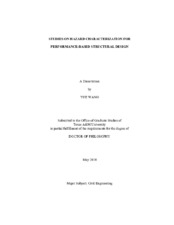| dc.description.abstract | Performance-based engineering (PBE) requires advances in hazard
characterization, structural modeling, and nonlinear analysis techniques to fully and
efficiently develop the fragility expressions and other tools forming the basis for
risk-based design procedures. This research examined and extended the state-of-the-art
in hazard characterization (wind and surge) and risk-based design procedures (seismic).
State-of-the-art hurricane models (including wind field, tracking and decay
models) and event-based simulation techniques were used to characterize the hurricane
wind hazard along the Texas coast. A total of 10,000 years of synthetic hurricane wind
speed records were generated for each zip-code in Texas and were used to statistically
characterize the N-year maximum hurricane wind speed distribution for each zip-code
location and develop design non-exceedance probability contours for both coastal and
inland areas.
Actual recorded wind and surge data, the hurricane wind field model, hurricane
size parameters, and a measure of storm kinetic energy were used to develop wind-surge and wind-surge-energy models, which can be used to characterize the wind-surge hazard
at a level of accuracy suitable for PBE applications. These models provide a powerful
tool to quickly and inexpensively estimate surge depths at coastal locations in advance of
a hurricane landfall. They also were used to create surge hazard maps that provide storm
surge height non-exceedance probability contours for the Texas coast.
The simulation tools, wind field models, and statistical analyses, make it possible
to characterize the risk-consistent hurricane events considering both hurricane intensity
and size. The proposed methodology for event-based hurricane hazard characterization,
when coupled with a hurricane damage model, can also be used for regional loss
estimation and other spatial impact analyses.
In considering seismic hazard, a risk-consistent framework for
displacement-based seismic design of engineered multistory woodframe structures was
developed. Specifically, a database of probability-based scale factors which can be used
in a direct displacement design (DDD) procedure for woodframe buildings was created
using nonlinear time-history analyses with suitably scaled ground motions records. The
resulting DDD procedure results in more risk-consistent designs and therefore advances
the state-of-the-art in displacement-based seismic design of woodframe structures. | en |


